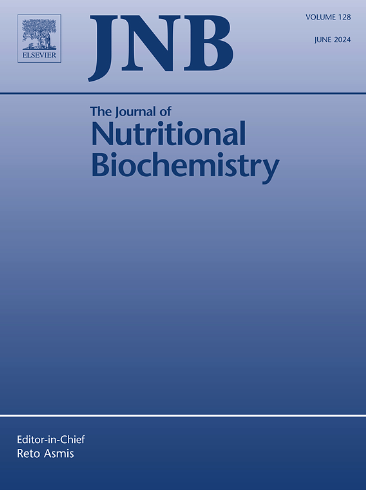Maternal exercise programs placental miR-495-5p-mediated Snx7 expression and kynurenic acid metabolic pathway induced by prenatal high-fat diet: Based on miRNA-seq, transcriptomics, and metabolomics
IF 4.8
2区 医学
Q1 BIOCHEMISTRY & MOLECULAR BIOLOGY
引用次数: 0
Abstract
Poor intrauterine environments increase the prevalence of chronic metabolic diseases in offspring, whereas maternal exercise is an effective measure to break this vicious intergenerational cycle. Placenta is increasingly being studied to explore its role in maternal-fetal metabolic cross-talk. The association between placental miRNA and offspring development trajectories has been established, yet the specific role and mechanism thereof in maternal exercise-induced metabolic protection remain elusive. Here, C57BL/6 female mice were subjected to either a normal control or a high-fat diet (HFD), half of the HFD-fed dams were housed with voluntary wheel running for 3 weeks before and during gestation. At embryonic day 18.5, we sacrificed parturient mice and then conducted miRNA-seq, transcriptomic, and metabolomic profiling of the placenta. Our data revealed that maternal HFD resulted in significant alterations in both miRNA and gene expressions, as well as metabolic pathways of the placenta, whereas prenatal exercise negated these perturbations. The common differentially expressed transcripts among three groups were enriched in multiple critical pathways involving energy expenditure, signal transduction, and fetal development. Through integrated analysis of multiomics data, we speculated that maternal exercise reversed the suppression of miR-495-5p induced by HFD, thereby inhibiting miR-495-5p-targeted Snx7 and modulating kynurenic acid production. These datasets provided novel mechanistic insight into how maternal exercise positively affects the metabolic homeostasis of offspring. The discovered important miRNAs, mRNAs, and metabolites could be promising predictive and therapeutic targets for protecting offspring metabolic health.

基于miRNA-seq、转录组学和代谢组学的产前高脂饮食诱导的胎盘mir -495-5p介导的Snx7表达和尿酸代谢途径
不良的宫内环境增加了后代慢性代谢性疾病的患病率,而母体运动是打破这种恶性代际循环的有效措施。人们越来越多地研究胎盘,以探索其在母胎代谢串扰中的作用。胎盘miRNA与子代发育轨迹的关系已经确立,但其在母体运动诱导的代谢保护中的具体作用和机制尚不清楚。实验中,C57BL/6雌性小鼠分别饲喂正常对照和高脂饮食(HFD),其中一半饲喂高脂饮食的小鼠在妊娠前和妊娠期间进行自愿轮跑饲养3周。在胚胎第18.5天,我们将胎鼠处死,然后对胎盘进行miRNA-seq、转录组学和代谢组学分析。我们的数据显示,母体HFD导致miRNA和基因表达以及胎盘代谢途径的显著改变,而产前运动则抵消了这些扰动。三组之间的共同差异表达转录本在涉及能量消耗、信号转导和胎儿发育的多个关键途径中富集。通过对多组学数据的综合分析,我们推测母体运动逆转了HFD诱导的miR-495-5p的抑制,从而抑制了miR-495-5p靶向的Snx7,调节了尿酸的产生。这些数据集为母亲运动如何积极影响后代代谢稳态提供了新的机制见解。发现的重要mirna、mrna和代谢物可能是保护后代代谢健康的有希望的预测和治疗靶点。
本文章由计算机程序翻译,如有差异,请以英文原文为准。
求助全文
约1分钟内获得全文
求助全文
来源期刊

Journal of Nutritional Biochemistry
医学-生化与分子生物学
CiteScore
9.50
自引率
3.60%
发文量
237
审稿时长
68 days
期刊介绍:
Devoted to advancements in nutritional sciences, The Journal of Nutritional Biochemistry presents experimental nutrition research as it relates to: biochemistry, molecular biology, toxicology, or physiology.
Rigorous reviews by an international editorial board of distinguished scientists ensure publication of the most current and key research being conducted in nutrition at the cellular, animal and human level. In addition to its monthly features of critical reviews and research articles, The Journal of Nutritional Biochemistry also periodically publishes emerging issues, experimental methods, and other types of articles.
 求助内容:
求助内容: 应助结果提醒方式:
应助结果提醒方式:


